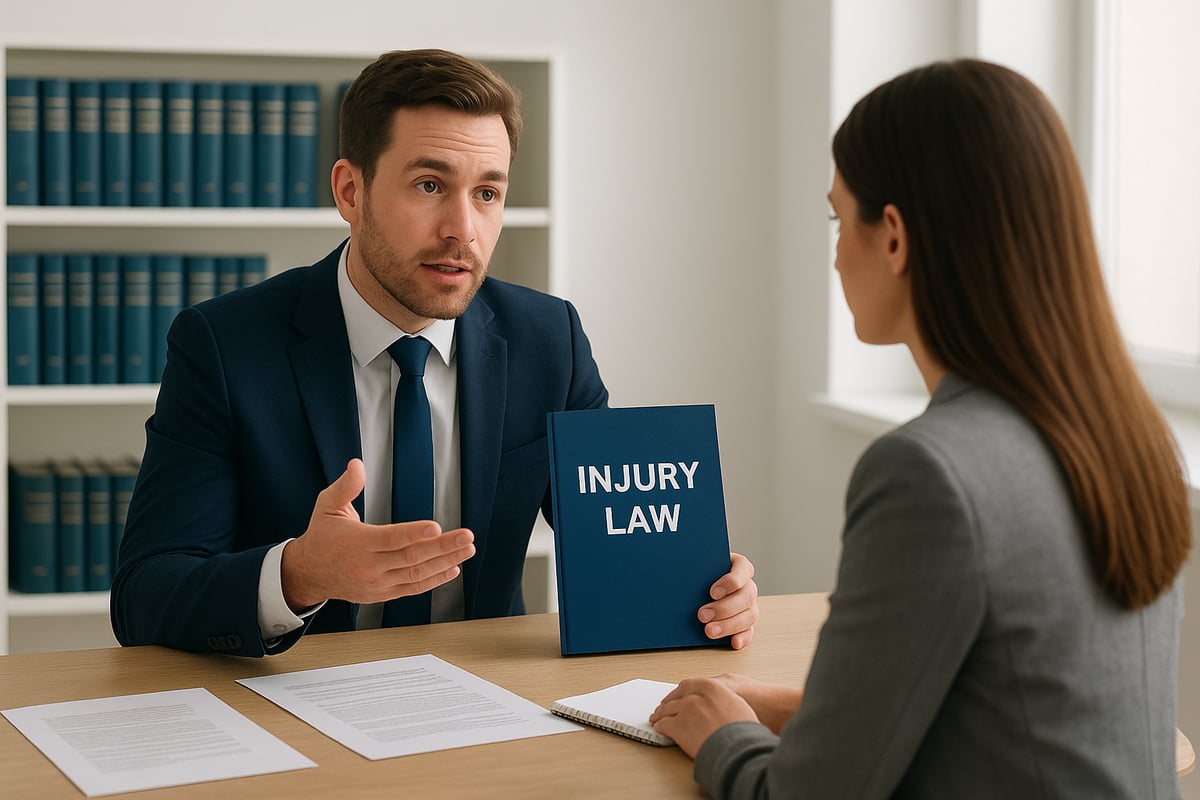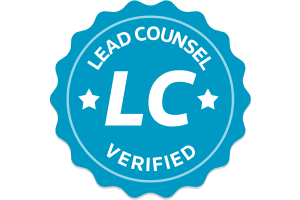- Free Consultation: 866-966-5240 Tap Here To Call Us
Injury Law Guide: Essential Insights for 2025
Unexpected injuries can disrupt lives in an instant, leaving individuals and families facing not only pain but also confusing legal hurdles. When these situations arise, understanding injury law becomes crucial for protecting your interests and making informed decisions.
This Injury Law Guide for 2025 delivers clear insights and the latest updates to help you navigate these challenges. You will learn the essentials of injury law, discover recent legal changes, and get step-by-step guidance for handling claims.
Inside, we explore the most common types of injury cases, explain your rights, outline the compensation process, and share expert advice on choosing the right attorney. Whether you are dealing with a recent accident or want to be prepared, this guide empowers you to take action and secure the recovery you deserve.
Understanding Injury Law: Foundations and Key Principles
Injury law serves as a vital safeguard for individuals who have suffered harm due to someone else’s negligence or wrongful acts. At its core, injury law is designed to ensure that those who are injured have a legal pathway to seek compensation and hold responsible parties accountable. This legal field protects the rights of victims while promoting safer conduct in society.
The foundation of most injury law claims lies in tort law. Tort law governs civil wrongs and provides remedies for those harmed by others. The majority of personal injury cases are built upon the concept that a party failed to meet a legally recognized duty, resulting in damage to another person. Understanding this legal structure is essential for anyone navigating injury law in 2025.
Every personal injury case must establish four key elements to succeed:
| Element | Description |
|---|---|
| Duty of Care | The defendant owed a legal responsibility to the plaintiff |
| Breach | The defendant failed to uphold that duty |
| Causation | The breach directly caused the injury |
| Damages | The plaintiff suffered actual harm as a result |
For an injury law claim to move forward, all four elements must be proven. If any are missing, the case may not be successful. This framework applies whether the harm was caused by negligence or intentional acts.
Negligence is the most common basis for injury law cases. It occurs when someone fails to act with the level of care that a reasonable person would use in similar circumstances. In contrast, intentional torts involve deliberate actions intended to cause harm, such as assault or battery. The way liability is established depends on whether the act was negligent or intentional.
Foreseeability plays an important role in determining responsibility. Courts often ask whether a reasonable person could have predicted the harm that occurred. For example, if a store owner fails to clean a spill and a customer slips, the injury was likely foreseeable. This principle helps define the limits of liability in injury law.
Real-world examples illustrate the diversity of injury law cases. Common scenarios include:
- Motor vehicle accidents, such as car or truck crashes.
- Premises liability cases, like slip and fall incidents in public spaces.
- Medical malpractice, involving errors by healthcare providers.
Each scenario demonstrates how injury law is applied to protect victims and encourage better safety practices.
Injury law evolves through both statutory law and case law. Statutory law consists of written laws passed by legislative bodies, which set out rights and responsibilities. Case law arises from judicial decisions, shaping how statutes are interpreted and applied. For instance, recent court rulings may redefine what constitutes negligence or clarify the scope of damages.
State-specific nuances are critical in injury law. For example, California follows a comparative negligence rule, allowing victims to recover damages even if they are partially at fault, though their compensation may be reduced accordingly. These variations can have a significant impact on the outcome of a claim.
Data shows that personal injury cases make up a significant share of civil litigation in the United States. According to recent Personal Injury Law Guide 2025 resources, the field is continually shaped by new legal standards and evolving case trends. Staying informed about these developments is crucial for anyone involved in an injury law claim.
Ultimately, understanding the principles and processes of injury law empowers individuals to protect their rights and pursue fair outcomes after an accident or injury.
Most Common Types of Injury Cases in 2025
Understanding the landscape of injury law in 2025 means recognizing which case types dominate the courts and claims process. From traffic collisions to medical errors, the spectrum of common cases is as varied as the challenges victims face. Recent statistics and trends in injury law show that certain injuries consistently lead the way, shaping how attorneys and victims approach legal recovery.
Motor Vehicle Accidents
Motor vehicle accidents continue to be the leading cause of injury law claims in 2025. These cases stem from collisions involving cars, trucks, motorcycles, bicycles, and pedestrians. One major trend is the increase in distracted driving, often due to mobile device usage. Additionally, the rise of rideshare services has introduced new complexities in determining liability.
- Common causes: Speeding, impaired driving, texting while driving
- New trends: Rideshare accidents, autonomous vehicle incidents
Data consistently show that motor vehicle accidents are the most frequently litigated cases in injury law, making them a central focus for legal professionals and victims alike.
Premises Liability and Slip & Fall
Premises liability cases arise when someone is injured on another party’s property due to unsafe conditions. Slip and fall accidents are a significant subset, often occurring in public spaces, businesses, or private residences. Typical scenarios include icy sidewalks, poorly maintained staircases, and inadequate lighting.
- Examples: Grocery store spills, broken handrails, lack of warning signs
- Recent developments: Increased verdicts in high-profile slip and fall lawsuits
Premises liability remains a vital area of injury law, as property owners are held to strict standards to ensure visitor safety.
Workplace and Construction Accidents
Workplace injuries, especially on construction sites, make up a substantial portion of injury law cases. Employees may be eligible for workers’ compensation, but many pursue third-party claims when negligence by someone other than their employer is involved.
- Common incidents: Falls from height, equipment failures, unsafe work environments
- Trends: Updates in labor laws, increased focus on safety compliance
Statutory protections, such as those in California, highlight how injury law adapts to changing workplace risks and regulations.
Medical Malpractice and Professional Negligence
Medical malpractice is a complex area of injury law involving claims against healthcare providers for substandard care. These cases often relate to surgical errors, misdiagnoses, or medication mistakes.
- Frequent claims: Birth injuries, anesthesia errors, delayed diagnosis
- Data point: Medical malpractice claims account for a significant share of large settlements
Due to the technical nature of these claims, injury law attorneys often rely on expert witnesses and detailed medical records to prove negligence.
Product Liability and Other Case Types
Product liability cases focus on injuries caused by defective products, dangerous drugs, or toxic exposures. In 2025, several high-profile recalls and class actions have brought attention to this area of injury law.
- Examples: Faulty electronics, contaminated food, harmful pharmaceuticals
- Other case types: Wrongful death, elder abuse, catastrophic injuries
These cases underscore the broad reach of injury law, protecting consumers and vulnerable individuals from harm caused by negligence or misconduct.
Recent Legal Changes and Trends Impacting Injury Law in 2025
Staying informed about recent legal changes is essential for anyone navigating injury law in 2025. The landscape continues to evolve rapidly, shaped by new legislation, technological advancements, and influential court decisions. Understanding these trends helps victims, attorneys, and insurers anticipate challenges and opportunities in the claims process.
Legislative Updates and New Regulations
The year 2025 brings significant legislative updates impacting injury law at both the federal and state levels. California, for instance, has revised its statute of limitations for certain injury claims, shortening the window for filing lawsuits in specific case types. New statutes also introduce changes to damages caps, particularly for non-economic damages in medical malpractice cases.
Liability standards have been clarified in response to public demand for transparency and fairness. For a comprehensive overview of current legal trends and statistics, see Personal Injury Law Statistics and Industry Trends for 2025. These updates underscore the importance of staying current with injury law changes to protect your rights.
Technological Advances and Their Legal Impact
Technology continues to redefine injury law in 2025. The rise of autonomous vehicles and wearable health devices introduces new forms of digital evidence, often central to proving liability and damages. Courts now routinely consider data from smart devices, dash cams, and even fitness trackers to establish timelines and causation.
Attorneys must adapt to these changes by understanding how to authenticate and challenge digital records. Recent cases show that admissibility standards are tightening, making expert testimony on technology increasingly vital. As injury law evolves, leveraging digital evidence can make or break a case.
Evolving Standards of Care and Duty
Societal expectations and industry standards play a growing role in shaping injury law. In 2025, updated building codes and workplace safety regulations reflect a heightened focus on accident prevention. For example, stricter requirements for fall protection in construction and mandatory surveillance in public venues set new benchmarks for duty of care.
These evolving standards influence how courts determine negligence. When a business or individual fails to meet updated norms, liability becomes easier to establish. Staying informed about these changes is crucial for both plaintiffs and defendants in injury law cases.
Insurance Industry Shifts
The insurance landscape is shifting, directly impacting injury law. Policy exclusions, increased claim denials, and adjustments to coverage terms are now more common. Insurers are adopting advanced analytics to flag potential fraud, which sometimes results in legitimate claims facing delays or disputes.
Data from 2025 indicates a rise in bad faith litigation as policyholders challenge unfair denials. The following table summarizes recent insurance trends affecting injury law:
| Trend | Impact on Injury Law |
|---|---|
| Policy Exclusions | Higher litigation rates |
| Claim Denials | More disputes and appeals |
| Analytics Use | Increased scrutiny of claims |
Understanding these shifts allows claimants to better prepare for the claims process.
Impact of Recent Court Decisions
Recent appellate and Supreme Court decisions are reshaping key aspects of injury law. Notable 2024–2025 verdicts have clarified what constitutes negligence, especially in cases involving new technologies and evolving standards of care. Some rulings have expanded the scope of recoverable damages, while others have emphasized strict adherence to procedural rules.
These decisions set important precedents that influence future claims and settlements. Staying updated on court developments ensures that individuals and attorneys can effectively navigate the complexities of injury law in 2025.
The Injury Claims Process: Step-by-Step Guide for 2025
Navigating the injury law claims process can feel overwhelming, especially when you are dealing with the aftermath of an accident. Understanding each step is essential for protecting your rights and building a strong case. Below is a clear, actionable guide to help you move forward with confidence.
Step 1: Immediate Actions After an Injury
Your first steps after an accident are critical for any injury law claim. Seek medical attention right away, even if injuries seem minor. Prompt documentation helps establish a clear link between the incident and your injuries.
Preserve all evidence at the scene. Take photographs of your injuries, property damage, and the surrounding area. Gather contact information from any witnesses, as their statements may be important later. Report the incident to the appropriate authorities, such as police, property owners, or your employer.
For an in-depth checklist on what to do immediately after an accident, review the Steps to Take After an Injury guide, which offers practical tips for this stage of the injury law process.
Step 2: Consulting an Injury Attorney
Once you are safe and your injuries are documented, consider consulting an attorney who specializes in injury law. Legal professionals can evaluate the strength of your case and explain your rights.
An attorney will review evidence, medical records, and insurance policies to determine your best course of action. Early legal intervention can help preserve crucial evidence, prevent common mistakes, and ensure that deadlines are met.
Choosing the right legal partner is vital, as experience in injury law can make a significant difference in the outcome of your claim. Many attorneys offer free consultations to discuss your options.
Step 3: Investigation and Evidence Gathering
The next phase in injury law involves a thorough investigation. Your attorney and legal team will collect all relevant documents, including medical records, accident reports, and any available surveillance footage.
Expert opinions may be sought, such as accident reconstruction specialists or medical experts, to clarify how the incident occurred and the extent of your injuries. Detailed evidence strengthens your case and supports your claim for damages.
Digital data, such as dash cam footage or text messages, can also play a pivotal role. Comprehensive evidence gathering is a cornerstone of a successful injury law claim.
Step 4: Filing the Claim and Negotiation
Once evidence is assembled, your injury law attorney will initiate claims with insurance companies or responsible parties. This step involves submitting demand letters that outline your losses and desired compensation.
Negotiation begins as insurers or defendants respond with settlement offers. Mediation may be used to reach a fair agreement. Most injury law cases resolve during this stage, avoiding the need for a trial.
Throughout negotiations, your attorney will advocate for your interests, aiming for a settlement that covers your medical expenses, lost wages, and other damages.
Step 5: Litigation and Trial Preparation
If negotiations stall, the injury law process moves to litigation. Your attorney files a lawsuit on your behalf, officially starting the court proceedings.
The discovery phase follows, where both sides exchange information through depositions, interrogatories, and document requests. Legal teams may prepare expert witnesses to testify on your behalf.
Pre-trial motions might address key legal issues before the case reaches court. Effective trial preparation is crucial to presenting a compelling injury law case.
Step 6: Trial and Post-Trial Actions
When a case goes to trial, injury law procedures include jury selection, opening statements, witness testimony, and closing arguments. The court then issues a verdict based on the evidence presented.
Possible outcomes include a favorable judgment, an unfavorable verdict, or a settlement reached during the proceedings. If necessary, appeals or post-trial motions can be filed to contest or clarify the result.
Understanding the trial process empowers you to make informed decisions at every stage of your injury law claim.
Step 7: Collecting Compensation and Enforcing Judgments
After a successful injury law verdict or settlement, the focus shifts to collecting compensation. Payments may be made as lump sums or structured settlements, depending on the agreement.
Sometimes, challenges arise with enforcement, such as delays in payment or disputes over amounts owed. Your attorney can assist with legal tools to enforce judgments and ensure you receive what you are entitled to.
Considerations for long-term care, future medical needs, and ongoing support are also addressed during this final step of the injury law process.
Compensation in Injury Cases: What Victims Need to Know
Understanding compensation is a cornerstone of injury law. After an accident or incident, knowing what damages you may recover and how they are calculated is crucial for protecting your rights and planning your recovery.
Types of Damages in Injury Law
Compensation in injury law includes several types of damages, each serving a specific purpose:
- Economic Damages: These cover measurable losses such as medical bills, lost wages, rehabilitation costs, and future medical care.
- Non-Economic Damages: These address more subjective losses, including pain and suffering, emotional distress, and loss of enjoyment of life.
- Punitive Damages: Awarded in rare cases, these are meant to punish especially reckless or intentional wrongdoing.
Victims should carefully document all financial and personal impacts to ensure a comprehensive injury law claim.
How Damages Are Calculated
Calculating damages under injury law involves a detailed review of medical expenses, anticipated future care, lost earning capacity, and other factors. Attorneys and insurance adjusters may use formulas, expert testimony, and case precedents to estimate fair value.
For example, in California, recent updates have modified caps on pain and suffering, directly affecting non-economic damages for plaintiffs. To explore more about how compensation is determined and what to expect, see Understanding Compensation in Injury Cases for expert tips and current guidance.
Limits on Damages and Comparative Fault
State laws often impose limits on certain damages. Statutory caps may restrict non-economic or punitive awards. In comparative negligence states, like California, your compensation may be reduced if you are found partially at fault.
For instance, if you are 20% responsible for an accident, your award may be reduced by the same percentage. This key principle in injury law ensures that liability is fairly distributed.
Tax Implications of Settlements and Verdicts
Not all compensation is tax-free. Generally, awards for physical injury or illness are not taxable, but damages for emotional distress or punitive damages may be. Always consult a tax professional to understand how injury law settlements could affect your finances.
Special Considerations: Wrongful Death and Catastrophic Injury
Wrongful death and catastrophic injury cases involve unique compensation rules. These claims may include damages for loss of companionship, future income, and long-term care needs. Injury law in 2025 continues to evolve, with states like California updating statutes to better protect families facing severe losses.
Average Settlement Amounts and Final Thoughts
Settlement amounts can vary widely by case type. For example, motor vehicle accidents often resolve in the tens of thousands, while complex medical malpractice or product liability cases may reach six or seven figures. Injury law aims to restore victims as fully as possible, but every case is unique.
Being informed about compensation helps you make better decisions and maximize your recovery. Understanding the basics of injury law, recent legal changes, and how damages are awarded ensures you are prepared at every step.
Choosing the Right Injury Attorney: What to Look for in 2025
Selecting the right attorney can make a significant difference in your injury law case. With evolving regulations and a competitive legal market, it is vital to choose a professional who is both knowledgeable and committed to your best interests.
Why Specialization in Injury Law Matters
Not all lawyers are equally equipped to handle injury law cases. Seek out attorneys who focus specifically on personal injury law, as they are more likely to understand the latest statutes, court decisions, and negotiation strategies. Specialized lawyers often anticipate potential challenges and know how to maximize your compensation.
Credentials and Track Record
When evaluating legal representation, review credentials such as board certification and membership in professional associations. A proven trial record is essential, as it demonstrates experience in both settlements and courtroom victories. Top-rated firms often highlight their multi-million dollar verdicts, which can be a strong indicator of their effectiveness.
| Key Factor | What to Look For |
|---|---|
| Specialization | Personal injury law focus |
| Credentials | Board certified, bar association member |
| Trial Record | Successful verdicts and settlements |
| Client Reviews | Positive feedback, testimonials |
Fee Structures and Transparency
Most injury law attorneys work on a contingency fee basis, meaning you pay nothing unless they win your case. Request a clear explanation of all fees during your first consultation. Transparency in fee agreements helps prevent misunderstandings and ensures you understand your financial obligations.
Accessibility and Personalized Service
A quality attorney should be accessible and responsive. Look for firms that offer multilingual services or are willing to meet clients at home or in hospitals if needed. Personalized service often leads to a better understanding of your unique situation and greater overall satisfaction.
Red Flags to Avoid
Be cautious of high-volume firms that rely on aggressive advertising but provide little individualized attention. Lack of communication, unclear fee structures, and reluctance to share past results are warning signs. For a comprehensive checklist, review this Choosing the Right Injury Lawyer guide, which outlines essential steps for selecting a reputable attorney.
Choosing an attorney with the right experience, credentials, and dedication to injury law can directly impact the outcome of your case. Take time to research, ask questions, and select a legal advocate who will fight for your rights.
Frequently Asked Questions About Injury Law in 2025
Navigating injury law can be overwhelming, especially as regulations and procedures evolve. Below, we answer some of the most common questions clients ask about injury law in 2025.
- What is the statute of limitations for injury law cases?
The statute of limitations varies by state. In California, you typically have two years from the date of injury to file a claim. Other states have different deadlines, so always verify your local laws. - How long does an injury law claim take to resolve?
Most claims settle within several months to a year, but complex cases or those that go to trial may take longer. - Can I recover damages if I was partially at fault?
Yes. Many states, including California, use comparative negligence rules. You may still recover compensation, but your award may be reduced by your percentage of fault. - What if the responsible party is uninsured or underinsured?
You may still pursue compensation through your own insurance, such as uninsured motorist coverage, or by seeking assets from the at-fault party. - Do I have to go to court, or can my case settle out of court?
Most injury law claims settle out of court through negotiation or mediation. Only a small percentage proceed to trial. - How are attorney fees structured in injury law cases?
Most attorneys work on a contingency fee basis, meaning they only get paid if you win or settle your case. - What should I do if the insurance company denies my claim?
Consult an attorney immediately. You may appeal the denial or file a lawsuit to protect your rights under injury law. - Where can I find more resources and support for injury law victims?
For updated statistics and trends, visit Personal Injury Law Statistics: Insights and Trends for 2025. Local bar associations and victim advocacy groups also offer valuable support.
As you navigate the complex landscape of injury law in 2025, it’s important to remember that every situation is unique and having the right guidance can make all the difference. Whether you’re dealing with a recent accident, trying to understand your rights, or seeking the compensation you deserve, you don’t have to face these challenges alone. Our Los Angeles-based team is here to provide clarity and support at every stage. If you have questions or are ready to take the next step, I invite you to reach out for a Free Consultation No Fee Until We Win.












